User:Enthusiast10/Sandbox
Transport in India consists of transport by land, water and air. Public transport remains the primary mode of transport for most Indian citizens, and India's public transport systems are among the most heavily used in the world.[1]
Motor vehicle population in India is low as per international standards, with only 24.85 million cars on the nation's roads as of 2013.[2] In total, about 21 per cent households have two wheelers whereas only 4.7 per cent of households in India have cars/jeeps/vans as per the 2011 Census.[3][4] Despite this, the number of deaths caused by traffic is amongst the highest in the world and increasing.[5][6] The automobile industry in India is currently rapidly growing with an annual production of over 4.6 million vehicles,[7] with an annual growth rate of 10.5%[3] and vehicle volume is expected to rise greatly in the future.[8]
India's rail network is the 4th longest and the most heavily used system in the world,[1] transporting 8.225 billion passengers and over 970 million tonnes of freight annually, as of 2015.[9] The railways transport about 18 million citizens daily.
In 2015–16, Government of India, declared 106 National Waterways (NW) under Inland Waterways Authority of India to reduce the cost of transportation and lower the carbon footprint by moving the traffic from surface roads and railroads to waterways.[10]
Despite ongoing improvements in the transport sector, several aspects of transportation are still riddled with problems due to outdated infrastructure and lack of investment in less economically active parts of the country. The demand for transport infrastructure and services has been rising by around 10% a year[1] with the current infrastructure being unable to meet these growing demands. According to Goldman Sachs, India will need to spend US$1.7 trillion on infrastructure projects over the next decade to boost economic growth.
Human/Animal powered
[edit]Walking
[edit]Walking constituted major form of transport in ancient times. People used to cover long distances on foot or bullock carts. For instance, Adi Sankaracharya travelled all over India from Kalady near Kochi.[11] Walking still constitutes an important mode of transport in urban areas.[12] In the city of Mumbai, to further improve the transit conditions for pedestrians, the Mumbai Metropolitan Region Development Authority, has commenced the construction of more than 50 skywalks,[13][14] as part of the Mumbai Skywalk project, which is very helpful as walk enthusiasts take part in reducing traffic.
Palanquins
[edit]
Palanquins, also known as palkis or pallakiis, was one of the luxurious methods primarily used by the rich and noblemen for travelling and also to carry a deity (idol) of a God. Many temples have sculptures of God being carried in a palki.[15] Modern use of the palanquin is limited to Indian weddings, pilgrimage and carrying idol of God.[16][17]
Bicycles
[edit]Bicycles (simply called cycles in India) have ownership rates ranging from around 30% to 75% at the state level.[4] Along with walking, cycling accounts for 50 to 80% of the commuter trips for those in the informal sector in urban areas.[12] However, recent developments suggest that bicycle riding is fast becoming popular in the metro cities of India. Today, government development authorities all over India encourages the setup and use of separate bicycle lanes alongside the roads to combat pollution and ease traffic congestion.[18]
Human-pulled rickshaws
[edit]
Human-pulled rickshaw are still available in various cities and villages in the country. Many local governments have proposed ban on these rickshaws describing them as "inhuman". The Government of West Bengal proposed a ban on these rickshaws in 2005.[19] Though a bill aiming to address this issue, termed as Calcutta Hackney Carriage Bill, was passed by the West Bengal Assembly in 2006, it has not been implemented yet.[20] The Government of West Bengal is working on an amendment of this bill to avoid the loopholes that got exposed when the Hand-pulled Rickshaw Owner's Association filed a petition against the bill.[20]
Cycle rickshaws
[edit]Cycle rickshaws were introduced in India in the 1940s.[21] They are bigger than a tricycle where two people sit on an elevated seat at the back and a person pedals from the front. In the late 2000s, they were banned in several cities for causing traffic congestion.[22][23][24] The Delhi Police recently submitted an affidavit against plying of cycle rickshaws to ease traffic congestion in the city but it was dismissed by the Delhi High Court.[25] In addition, environmentalists have supported the retention of cycle rickshaws as a non-polluting and inexpensive mode of transport.[26]
Bullock carts/Horse carriages
[edit]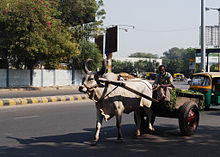
Bullock carts have been traditionally used for transport, especially in rural India. The arrival of the British saw drastic improvements in the horse carriages which were used for transport since early days. Today, they are used in smaller towns and are referred as Tanga or buggies. Victorias of Mumbai are still used for tourist purposes, but horse carriages are now rarely found in the cities of India.[27] In recent years cities have banned the movement of slow moving vehicles on the main roads.[28][29][30]
Road
[edit]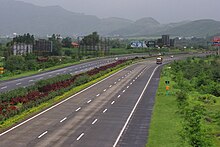
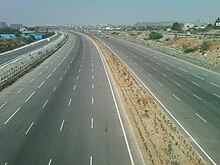
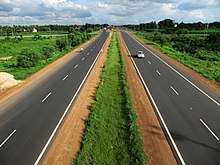
As per 2013 estimates, the total road length in India is 4,689,842 km (2,914,133 mi);[31] making the Indian road network the second largest road network in the world after the United States. At 0.66 km of highway per square kilometre of land the density of India's highway network is higher than that of the United States (0.65) and far higher than that of China's (0.16) or Brazil's (0.20).[1]
India has a network of National Highways connecting all the major cities and state capitals, forming the economic backbone of the country. As of 2013, India has a total of 70,934 km (44,076 mi) of National Highways, of which 1,208 km (751 mi) are classified as expressways.[32]
As per the National Highways Authority of India, about 65% of freight and 80% passenger traffic is carried by the roads. The National Highways carry about 40% of total road traffic, though only about 2% of the road network is covered by these roads.[32] Average growth of the number of vehicles has been around 10.16% per annum over recent years.[32]
Under National Highways Development Project (NHDP), work is under progress to equip national highways with four lanes; also there is a plan to convert some stretches of these roads to six lanes.[33] All national highways are metalled, but very few are constructed of concrete, the most notable being the Mumbai-Pune Expressway. In recent years construction has commenced on a nationwide system of multi-lane highways, including the Golden Quadrilateral and North-South and East-West Corridors which link the largest cities in India.
In 2000, around 40% of villages in India lacked access to all-weather roads and remained isolated during the monsoon season.[1][34] To improve rural connectivity, Pradhan Mantri Gram Sadak Yojana (Prime Minister's Rural Road Program), a project funded by the Central Government with the help of World Bank, was launched in 2000 to build all-weather roads to connect all habitations with a population of 500 or above (250 or above for hilly areas).[34][35]
Generally, traffic in most of the cities in India moves slowly, where traffic jams and accidents are very common, but in some cities like Chandigarh, wide roads and less vehicles contribute to lesser traffic.[36][37] India has very poor records on road safely—around 90,000 people die from road accidents every year.[38] At least 13 people die every hour in road accidents in the country, also in the year 2007 road accidents claimed more than 130,000 lives, overtaking China.[39][40] A Reader's Digest study of traffic congestion in Asian cities ranked several Indian cities within the Top Ten for worst traffic.[37]
| Type of Road | Length |
|---|---|
| Expressways | 1,208 km (751 mi) as of 2011 |
| National Highways | 79,116 km (49,160 mi) |
| State Highways | 155,716 km (96,757 mi) |
| District, Rural and Other Roads | 4,455,010 km (2,768,210 mi) |
| Total Length | 4,689,842 km (2,914,133 mi) (Approx) |
Bus
[edit]
Buses are an important means of public transport in India. Due to this social significance, bus transport is predominantly owned and operated by public agencies, and most state governments operate bus services through a State Road Transport Corporation.[41] These corporations have proven extremely useful in connecting villages and towns across the country.[42] However, the share of buses is negligible in most Indian cities as compared to personalised vehicles, and two-wheelers and cars account for more than 80 percent of the vehicle population in most large cities.[42]Many Indian states government have their own fleet of buses which are run under their State Transport Department. Some of the top bus fleet are as follows:
| Sr. No. | State | Bus Fleet of all STU's |
|---|---|---|
| 1 | Karnataka | 23138 |
| 2 | Tamilnadu | 23078 |
| 3 | Maharashtra | 16000 |
| 4 | Uttar pradesh | 11851 |
| 5 | Andhra pradesh | 11785 |
| 6 | Telangana | 10479 |
| 7 | Gujarat | 9100 |
| 8 | Kerala | 6240 |
| 9 | Rajasthan | 5500 |
| 10 | Haryana | 4250 |
| 11 | Punjab | 2909 |
| 12 | Himachal pradesh | 2645 |
| 13 | West bengal | 2345 |
| 14 | Uttrakhand | 1419 |
| 15 | Assam | 585 |
| 16 | Goa | 565 |
| 17 | Jammu & Kashmir | 529 |
| 18 | Orissa | 462 |
| 19 | Bihar | 306 |
Bus Rapid Transit System
[edit]
Bus Rapid Transit Systems (BRTS), exist in several cities of the country.[43] Buses take up over 90% of public transport in Indian cities,[44] and serve as an important mode of transport. Services are mostly run by state government owned Transport Corporations.[42] In 1990s all government State Transport Corporations have introduced various facilities like low-floor buses for the disabled and air-conditioned buses to attract private car owners to help decongest roads.[45][46] Rainbow BRTS in Pune is the first BRTS system in the country. Mumbai introduced air conditioned buses in 1998.[47] Bangalore was the first city in India to introduce Volvo B7RLE intra-city buses in India in January 2005 .[48][49][50] Bangalore is the first Indian city to have an air-conditioned bus stop, located near Cubbon Park. It was built by Airtel.[51] The city of Chennai houses one of Asia's largest bus terminus, the Chennai Mofussil Bus Terminus.[52]
Motor vehicles
[edit]Two-wheelers
[edit]Motorised two-wheeler vehicles like scooters, motorcycles and mopeds are very popular mode of transport due to their fuel efficiency and ease of use in congested roads or streets. The number of two-wheelers sold is several times that of cars. There were 47.5 million powered two-wheelers in India in 2003 compared with just 8.6 million cars.[53]
Manufacture of motorcycles in India started when Royal Enfield began assembly in its plant in Chennai in 1948. Royal Enfield, an iconic brand name in the country, manufactures different variants of the British Bullet motorcycle which is a classic motorcycle that is still in production.[54] Hero MotoCorp (formerly Hero Honda), Honda, Bajaj Auto, Yamaha, TVS Motors and Mahindra 2 Wheelers are the largest two-wheeler companies in terms of market-share.[55]
Manufacture of scooters in India started when Automobile Products of India (API), set up at Mumbai and incorporated in 1949, began assembling Innocenti-built Lambretta scooters in India.[citation needed] They eventually acquired licence for the Li150 series model, of which they began full-fledged production from the early sixties onwards.[citation needed] In 1972, Scooters India Ltd (SIL), a state-run enterprise based in Lucknow, Uttar Pradesh, bought the entire manufacturing rights of the last Innocenti Lambretta model. API has infrastructural facilities at Mumbai, Aurangabad, and Chennai but has been non-operational since 2002. SIL stopped producing scooters in 1998.[citation needed]
Motorcycles and scooters can be rented in many cities, Wicked Ride, Metro bikes and many other companies are working with state governments to solve last mile connectivity problems with mass transit solutions.[56] Wearing protective headgear is mandatory for both the rider and the pillion-rider in most cities.[57]
Automobiles
[edit]Private automobiles account for 30% of the total transport demand in urban areas of India. An average of 963 new private vehicles are registered every day in Delhi alone.[58] The number of automobiles produced in India rose from 6.3 million (6.3 million) in 2002–03 to 11 million (11.2 million) in 2008–09.[59] However, India still has a very low rate of car ownership. When comparing car ownership between BRIC developing countries, it is on a par with China,[60] and exceeded by Brazil and Russia.[60]
Compact cars, especially hatchbacks predominate due to affordability, fuel efficiency, congestion, and lack of parking space in most cities. Chennai is known as the "Detroit of India" for its automobile industry.[61] Maruti, Hyundai and Tata Motors are the most popular brands in the order of their market share. The Ambassador once had a monopoly but is now an icon of pre-liberalisation India, and is still used by taxi companies. Maruti 800 launched in 1984 created the first revolution in the Indian auto sector because of its low pricing. It had the highest market share until 2004, when it was overtaken by other low-cost models from Maruti such as the Alto and the Wagon R, the Indica from Tata Motors and the Santro from Hyundai. Over the 20-year period since its introduction, about 2.4 million units of the Maruti 800 have been sold.[62] However, with the launch of the Tata Nano, the least expensive production car in the world, Maruti 800 lost its popularity.[63]
India is also known for a variety of indigenous vehicles made in villages out of simple motors and vehicle spare-parts. A few of these innovations are the Jugaad, Maruta, Chhakda, Peter Rehda and the Fame.[64]
In the city of Bangalore, Radio One and the Bangalore Traffic Police, launched a carpooling drive which has involved celebrities such as Robin Uthappa, and Rahul Dravid encouraging the public to carpool.[65][66][67] The initiative got a good response, and by the end of May 2009, 10,000 people are said to have carpooled in the city.[68]
Utility vehicles
[edit]The first utility vehicle in India was manufactured by Mahindra. It was a copy of the original Jeep and was manufactured under licence.[69] The vehicle was an instant hit and made Mahindra one of the top companies in India. The Indian Army and police extensively use Mahindra vehicles along with Maruti Gypsys for transporting personnel and equipment.
Tata Motors, the automobile manufacturing arm of the Tata Group, launched its first utility vehicle, the Tata Sumo, in 1994.[70][71] The Sumo, owing to its then-modern design, captured a 31% share of the market within two years.[72] The Tempo Trax from Force Motors till recently was ruling the rural areas. Sports utility vehicles now form a sizeable part of the passenger vehicle market.[73] Models from Tata, Honda, Hyundai, Ford, Chevrolet and other brands are available.[74]
Taxis
[edit]
Most of the taxicabs in India are either Premier Padmini or Hindustan Ambassador cars.[75] Depending on the city/state, taxis can either be hailed or hired from taxi-stands. In cities such as Bangalore, Hyderabad and Ahmedabad, taxis need to be hired over phone,[76] whereas in cities like Kolkata and Mumbai, taxis can be hailed on the street. According to government of India regulations, all taxis are required to have a fare-meter installed.[77] There are additional surcharges for luggage, late-night rides and toll taxes are to be paid by the passenger. Since 2006, radio taxis have become increasingly popular with the public due to reasons of safety and convenience.[78]
In cities and localities where taxis are expensive or do not ply as per the government or municipal regulated fares, people use share taxis. These are normal taxis which carry one or more passengers travelling to destinations either en route to the final destination, or near the final destination.[citation needed] The passengers are charged according to the number of people with different destinations.[citation needed] The city of Mumbai will soon be the first city in India, to have an "in-taxi" magazine, titled MumBaee, which will be issued to taxis which are part of the Mumbai Taximen's Union. The magazine debuted on 13 July 2009.[79] In Kolkata, there are many no refusal taxi available with white and blue in colour.[80]
Auto Rickshaws
[edit]
An auto rickshaw is a three-wheeler vehicle for hire that does not have doors and is generally characterised by a small cabin for the driver in the front and a seat for passengers in the rear.[81] Generally it is painted in yellow, green or black color and has a black, yellow or green canopy on the top, but designs vary considerably from place to place. The color of the autorickshaw is also determined by the fuel that it is powered by, for example Agartala, Ahmedabad, Mumbai and Delhi have green or black autos indicating the use of compressed natural gas, whereas the autos of Kolkata, Bangalore have green autos indicating the use of LPG.[citation needed]
In Mumbai and other metropolitan cities, 'autos' or 'rickshaws' as they are popularly known have regulated metered fares. A recent law prohibits auto rickshaw drivers from charging more than the specified fare, or charging night-fare before midnight, and also prohibits the driver from refusing to go to a particular location. Mumbai and Kolkata are also the only two cities which prohibit auto rickshaws from entering a certain part of the city, in these cases being South Mumbai and certain parts of Downtown Kolkata.[82] However, in cities like Chennai, it is common to see autorickshaw drivers demand more than the specified fare and refuse to use fare meter.[83]
Airports and railway stations at many cities such as Howrah, Chennai and Bangalore provide a facility of prepaid auto booths, where the passenger pays a fixed fare as set by the authorities for various locations.[84]
Electric rickshaw is new popular means of transport, rapidly growing in number in India, due to low running and initial cost, other economic and environment benefits, these vehicles are becoming popular in India. E-Rickshaws are made in fiberglass or metal body, powered by a BLDC Electric Motor with max power 2000W and speed 25 km/h.
Rail
[edit]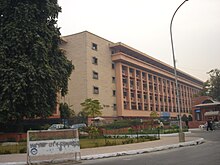


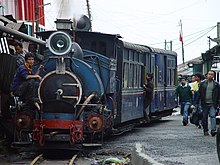
Country-wide rail services in India, are provided by the state-run Indian Railways under the supervision of the Ministry of Railways. Indian Railways is divided into seventeen zones including the Kolkata Metro Railway.[86] The Indian Railways are further sub-divided into sixty seven divisions, each having a divisional headquarters.[87][88]
The railway network traverses through the length and breadth of the country, covering more than 7,000 stations over a total route length of more than 65,000 km (40,000 mi) and track length of about 115,000 km (71,000 mi).[89] About 22,224 km (13,809 mi) or 34% of the route-kilometre was electrified as on 31 March 2012.[90] Indian Railways provides an important mode of transport in India, transporting over 18 million passengers and more than 2 million tonnes of freight daily across one of the largest and busiest rail networks in the world.[89] Indian Railways is the world's largest commercial or utility employer, with more than 1.4 million employees.[91][92] As to rolling stock, IR owns over 200,000 (freight) wagons, 50,000 coaches and 8,000 locomotives.[91] It also owns locomotive and coach production facilities. It operates both long distance and suburban rail systems on a network of 5 ft 6 in (1,676 mm) broad gauge.
The Indian Railways runs a number of special types of services which are given higher priority. The Rajdhani trains introduced in 1969 provides connectivity between the national capital, Delhi and capitals of the states. On the other hand, Shatabdi Express provides connectivity between centres of tourism, pilgrimage or business. The Shatabdi Express trains run over short to medium distances and do not have sleepers while the Rajdhani Expresses run over longer distances and have only sleeping accommodation. Both series of trains have a maximum permissible speed of 110 to 140 km/h (81 to 87 mph) but average speed of less than 100 km/h.[citation needed]. The Duronto Express (without any commercial stop between the origin and the destination but with a few technical stops for crew change and food intake) and Garib Raths express that provide cheap no-frill airconditioned rail travel.
Besides, the Indian Railways also operates a number of luxury trains which cater to various tourist circuits. For instance, the Palace on Wheels serves the Rajasthan circuit and The Golden Chariot serves the Karnataka and Goa circuits.[citation needed] There are two UNESCO World Heritage Sites on Indian Railways, the Chhatrapati Shivaji Maharaj Terminus[93] and the Mountain railways of India.[94] The latter consists of three separate railway lines located in different parts of India, the Darjeeling Himalayan Railway, a 610 mm (2 ft) narrow gauge railway in Lesser Himalayas in West Bengal, the Nilgiri Mountain Railway, a 1,000 mm (3 ft 3+3⁄8 in) metre gauge rack railway in the Nilgiri Hills in Tamil Nadu and the Kalka-Shimla Railway, a 762 mm (2 ft 6 in) narrow gauge railway in the Siwalik Hills in Himachal Pradesh.[95]
In India, freight (goods) trains can carry standard containers double-stacked on flat-bed wagons with normal axle load of about 22 tonnes and do not require special low-bed wagons unlike in other countries that have (relatively narrow) 1,435 mm (4 ft 8+1⁄2 in) standard gauge. They carry almost 4000 tonnes per rake which is almost twice the load a normal goods train can haul. Some double-stacked container freight trains on the route through Rewari station also carry "high cube" containers that are 2896 mm (9 ft 6-inch) high (higher than standard containers that are generally 8 ft or 2.438 mm high) on special low-well wagons owned by private clients. Some private logistics operators have built container storage yards north of Rewari near Garhi Harsaru for this purpose.[citation needed]
In 1999, the Konkan Railway Corporation introduced the Roll on Roll off (RORO) service, a unique road-rail synergy system, on the section between Kolad in Maharashtra and Verna in Goa,[96] which was extended up to Surathkal in Karnataka in 2004.[97][98] The RORO service, the first of its kind in India, allowed trucks to be transported on flatbed trailers. It was highly popular,[99] carrying about 110,000 trucks and bringing in about ₹ 740 million worth of earnings to the corporation till 2007.[100]
High-speed rail
[edit]India does not have any railways classified as high-speed rail (HSR), which have operational speeds in excess of 200 km/h (120 mph).[101] The fastest train in India is the Gatimaan Express with a top speed of 160 km/h (99 mph),[102][103] which runs between Delhi and Agra.[104]
Prior to the 2014 general election, the two major national parties (Bharatiya Janata Party and Indian National Congress(INC)) pledged to introduce high-speed rail. The INC pledged to connect all of India's million-plus cities by high-speed rail,[105] whereas BJP, which won the election, promised to build the Diamond Quadrilateral project, which would connect the cities of Chennai, Delhi, Kolkata, and Mumbai via high-speed rail.[106] This project was approved as a priority for the new government in the incoming prime minister's speech.[107] Construction of one kilometer of high speed railway track will cost ₹100 crore (US$12 million) – ₹140 crore (US$16 million) which is 10-14 times higher than the construction of standard railway.[108]
India's prime minister Narendra Modi approved the choice of Japan to build India's first high-speed railway. The planned rail would run some 500 km (310 mi) between Mumbai and the western city of Ahmedabad, at a top speed of 320 km/h (200 mph).[109][110] Under the proposal, construction is expected to begin in 2017 and be completed in 2023. It would cost about ₹980 billion (US$11 billion) and be financed by a low-interest loan from Japan.[111] India will use the wheel-based 300 km/hr HSR technology, instead of new maglev 600 km/hr technology of the Japan used in Chūō Shinkansen. India is expected to have its HSR line operational from 2025 onwards, once the safety checks are completed.
Rail links with adjoining countries
[edit]
Rail links between India and neighbouring countries are not well-developed. Two trains operate to Pakistan—the Samjhauta Express between Delhi and Lahore, and the Thar Express between Jodhpur and Karachi. Bangladesh is connected by a biweekly train, the Maitree Express that runs from Kolkata to Dhaka. Two rail links to Nepal exist—passenger services between Jainagar and Bijalpura, and freight services between Raxaul and Birganj.[112]
Indian and Bangladeshi governments will start work late by December or early by January 2015 on a new rail link to ease surface transport.[113] India will build a 15-km railway tracks linking Tripura's capital Agartala with Bangladesh's southeastern city of Akhaura, an important railway junction connected to Chittagong port, resource-rich Sylhet and Dhaka.[114] An agreement to implement the railway project was signed between India's former Prime Minister Manmohan Singh and Bangladesh Premier Sheikh Hasina during her visit to India in January 2010.[115] Total cost of the proposed project is estimated at Rs.252 crore. The Indian Railway Construction Company (IRCON) would lay the new railway tracks on both sides of the border. Of the 15 km rail line, five km of tracks fall in the Indian territory.[116][117] The NFR is now laying tracks to connect Tripura's southern most border town Sabroom, 135 km south of here. From Sabroom, the Chittagong international sea port is just 72 km.[118]
No rail link exists with Myanmar but a railway line is to be built through from Jiribam (in Manipur) to Tamu through Imphal and Moreh.[119] The construction of this missing link, as per the feasibility study conducted by the Ministry of External Affairs through RITES Ltd, is estimated to cost ₹29.41 billion (US$340 million).[120] An 18 km railway link with Bhutan is being constructed from Hashimara in West Bengal to Toribari in Bhutan. No rail link exists with either China or Sri Lanka.[121]
Suburban rail
[edit]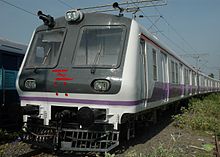
The suburban railway services in India are operational in Mumbai, Kolkata, Pune, Chennai, Delhi and Hyderabad and Bengaluru.[42]
The Mumbai Suburban Railway is the first rail system in India which began services in Mumbai in 1853, transports 6.3 million passengers daily and has the highest passenger density in the world.[122] The Kolkata Suburban Railway, was established in Kolkata in 1854, and is the largest suburban network in the country according to no of stations and route length.[123] Chennai Suburban Railway is an important mode of transport in Chennai. Delhi Suburban Railway serves the NCR and surrounding areas.
Metro
[edit]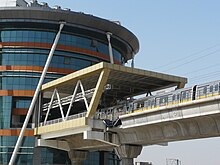
The first modern rapid transit in India is the Kolkata Metro and started its operations in 1984, this is also the 17th Zone of the Indian Railways.[124] The Delhi Metro in New Delhi is India's second conventional metro and began operations in 2002. The Namma Metro in Bangalore is India's third operational rapid transit and began operations in 2011. Mumbai Metro seves Mumbai and adjoining areas.
Currently, rapid transit are under construction or in planning in several major cities of India and will be opened shortly.
Monorail
[edit]
Monorail is generally considered as feeder system for the Metro trains in India. The Mumbai Monorail, which started in 2014, is the first operational monorail network in India[125] (excluding the Skybus Metro Test Track in Goa) since the Patiala State Monorail Trainways closed in 1927.
Light rail
[edit]Like monorail, light rail is also considered as a feeder system for the Metro systems. Two light rail projects have been proposed respectively in Delhi and Kolkata. There would be total number of 68 stations of light rail in India. Also, light rail proposal for other cities is currently in discussion.
Tram
[edit]
The arrival of British rule in India saw trams in addition to trains, being introduced in many cities.
The trams in Kolkata is currently the only tram system in the country and provides an emission-free means of transport in Kolkata while the other tram systems in India were phased out. The nationalised Calcutta Tramways Company is in the process of upgrading the existing tramway network at a cost of ₹240 million (US$2.8 million).[126]
Air
[edit]
Directorate General of Civil Aviation is the national regulatory body for the aviation industry. It is controlled by the Ministry of Civil Aviation. The ministry also controls aviation related autonomous organisations like the Airports Authority of India (AAI), Bureau of Civil Aviation Security (BCAS), Indira Gandhi Rashtriya Uran Akademi and Public Sector Undertakings including Air India, Pawan Hans Helicopters Limited and Hindustan Aeronautics Limited.[127]
Air India is India's national flag carrier after merging with Indian (airline) in 2011[128] and plays a major role in connecting India with the rest of the world.[129] IndiGo, Jet Airways, Air India, Spicejet and GoAir are the major carriers in order of their market share.[130] These airlines connect more than 80 cities across India and also operate overseas routes after the liberalisation of Indian aviation. Several other foreign airlines connect Indian cities with other major cities across the globe. However, a large section of country's air transport potential remains untapped, even though the Mumbai-Delhi air corridor was ranked 10th by Amadeus in 2012 among the world's busiest routes.[131][132]

Airports
[edit]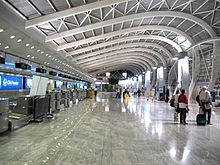

While there are 346[133] civilian airfields in India – 253 with paved runways and 93 with unpaved runways, only 132 were classified as "airports" as of November 2014.[134] Of these, Indira Gandhi International Airport in Delhi is the busiest in the country.[135][136][137] The operations of the major airports in India have been privatised over the past 5 years and this has resulted in better equipped and cleaner airports. The terminals have either been refurbished or expanded.
India also has 33 "ghost airports," which were built in an effort to make air travel more accessible for those in remote regions but are now non-operational due to a lack of demand. The Jaisalmer Airport in Rajasthan, for example, was completed in 2013 and was expected to host 300,000 passengers a year but has yet to see any commercial flights take off. Despite the number of non-operational airports, India is currently planning on constructing another 200 "low-cost" airports over the next 20 years.[138]
| Length of runways | Airports with paved runways[133] |
Airports with unpaved runways[133] |
|---|---|---|
| 3,047 m (10,000 ft) or more | 21 | 1 |
| 2,438 to 3,047 m (8,000 to 10,000 ft) | 59 | 3 |
| 1,524 to 2,438 m (5,000 to 8,000 ft) | 76 | 6 |
| 914 to 1,524 m (3,000 to 5,000 ft) | 82 | 38 |
| Under 914 m (3,000 ft) | 14 | 45 |
| Total | 253 | 93 |
Heliports
[edit]
As of 2013, there are 45 heliports in India.[133] India also has the world's highest helipad at the Siachen Glacier at a height of 6400 m (21,000 ft) above mean sea level.[139]
Established in 1977, Heliport Systems, Inc. plans, designs, and constructs heliports for hospitals, businesses, and the marine industry worldwide. For rooftops, we manufacture a modular, steel and aluminum, Rooftop Heliport System, complete with Heliport Lighting and Heliport Foam Fire Protection. For ships and offshore oil rigs where ultra light weight and immunity from corrosion are essential, we manufacture a prefabricated all-aluminum heliport system. Our services range from – professional site selection; compliance with aeronautics regulations; engineering design; manufacture of helidecks, heliport lighting, and heliport fire protection equipment – to turnkey construction. All services and products are fully insured.
Pawan Hans Helicopters Limited is a public sector company that provides helicopter services to ONGC to its off-shore locations, and also to various State Governments in India, particularly in North-east India.[140]
Water
[edit]India has a coastline of 7,517 km (4,671 mi),[141] and thus ports are the main centres of trade.
India also has an extensive network of inland waterways.
Ports and shipping
[edit]
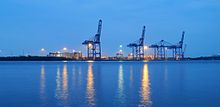
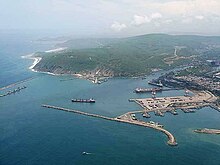
In India about 95% of the foreign trade by quantity and 70% by value takes place through the ports.[143] Mumbai Port & JNPT(Navi Mumbai) handles 70% of maritime trade in India.[144] There are twelve major ports: Navi Mumbai, Mumbai, Kochi, Kolkata (including Haldia), Paradip, Visakhapatnam, Ennore, Chennai, Tuticorin, New Mangaluru, Mormugao and Kandla.[145] Other than these, there are 187 minor and intermediate ports, 43 of which handle cargo.[145]
Maritime transportation in India is managed by the Shipping Corporation of India, a government-owned company that also manages offshore and other marine transport infrastructure in the country. It owns and operates about 35% of Indian tonnage and operates in practically all areas of shipping business servicing both national and international trades.The only state which carries three ports in India is Tamil Nadu, they are Ennore, Chennai and Tuticorin.[146]
It has a fleet of 79 ships of 2750,000 GT (4.8 million DWT) and also manages 53 research, survey and support vessels of 120,000 GT (060,000 DWT) on behalf of various government departments and other organisations.[147] Personnel are trained at the Maritime Training Institute in Mumbai, a branch of the World Maritime University, which was set up in 1987.[148] The Corporation also operates in Malta and Iran through joint ventures.[147]
The distinction between major and minor ports is not based on the amount of cargo handled. The major ports are managed by port trusts which are regulated by the central government.[149] They come under the purview of the Major Port Trusts Act, 1963.[150][citation needed] The minor ports are regulated by the respective state governments and many of these ports are private ports or captive ports.[150][citation needed] The total amount of traffic handled at the major ports in 2005–2006 was 382.33 Mt.[145]
Waterways
[edit]
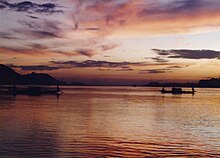
India has an extensive network of inland waterways in the form of rivers, canals, backwaters and creeks. The total navigable length is 14,500 kilometres (9,000 mi), out of which about 5,200 km (3,231 mi) of river and 485 km (301 mi) of canals can be used by mechanised crafts.[151] Freight transport by waterways is highly underutilised in India compared to other large countries. The total cargo moved by inland waterways is just 0.15% of the total inland traffic in India, compared to the corresponding figures of 20% for Germany and 32% for Bangladesh.[152]
Cargo that is transported in an organised manner is confined to a few waterways in Goa, West Bengal, Assam and Kerala.[citation needed] The Inland Waterways Authority of India (IWAI) is the statutory authority in charge of the waterways in India. It does the function of building the necessary infrastructure in these waterways, surveying the economic feasibility of new projects and also administration and regulation.[citation needed] The following waterways have been declared as National Waterways:
- National Waterway 1: Allahabad–Haldia stretch of the Ganga – Bhagirathi – Hooghly river system with a total length of 1,620 kilometres (1,010 mi) in October 1986.[153]
- National Waterway 2: Saidiya–Dhubri stretch of the Brahmaputra river system with a total length of 891 kilometres (554 mi) in 1988.[153]
- National Waterway 3: Kollam–Kottapuram stretch of the West Coast Canal along with Champakara and Udyogmandal canals, with a total length of 205 kilometres (127 mi) in 1993.[153]
- National Waterway 4: Bhadrachalam–Rajahmundry and Wazirabad–Vijaywada stretch of the Krishna–Godavari river system along with the Kakinada–Pondicherry canal network, with a total length of 1,095 km (680 mi) in 2007.[154][155]
- National Waterway 5: Mangalgadi–Paradeep and Talcher–Dhamara stretch of the Mahanadi–Brahmani river system along with the East Coast Canal, with a total length of 623 km (387 mi) in 2007.[154][155]
Pipelines
[edit]- Length of pipelines for crude oil is 20,000 km (12,427 mi).
- Length of Petroleum products pipeline is 15,000 kilometres (9,300 mi).
Environmental issues and impact
[edit]The National capital New Delhi has one of the largest CNG based transport systems as a part of the drive to bring down pollution. In spite of these efforts it remains the largest contributor to the greenhouse gas emissions in the city.[156] The CNG Bus manufacturers in India are Ashok Leyland, Tata Motors, Swaraj Mazda and Hindustan Motors.[157]
In 1998, the Supreme Court of India published a Directive that specified the date of April 2001 as deadline to replace or convert all buses, three-wheelers and taxis in Delhi to compressed natural gas.[158]
The Karnataka State Road Transport Corporation was the first State Transport Undertaking in India to utilise bio-fuels and ethanol-blended fuels.[159] KSRTC took an initiative to do research in alternative fuel forms by experimenting with various alternatives— blending diesel with biofuels such as honge, palm, sunflower, groundnut, coconut and sesame.[160] In 2009, the corporation decided to promote the use of biofuel buses.[161]
In 2017, the government announced that by 2030, only electric vehicles would be sold in the country.[162] It also announced that by 2022 all trains would be electric trains.[163]
See also
[edit]- Traffic collisions in India
- North-South Transport Corridor
- Ashgabat agreement, a Multimodal transport agreement signed by India, Oman, Iran, Turkmenistan, Uzbekistan and Kazakhstan, for creating an international transport and transit corridor facilitating transportation of goods between Central Asia and the Persian Gulf.[164]
Notes
[edit]References
[edit]- ^ a b c d e "India Transport Sector". World Bank.
- ^ "Registered Motor Vehicles in India 1951–2013" (CSV). data.gov.in. 2014. p. 1.
- ^ a b "MOTOR VEHICLE WRITUP – Statistical Year Book, India 2015" (PDF). Ministry of Statistics and Programme Implementation. 2015. p. 7. Archived from the original (PDF) on 13 November 2015. Retrieved 19 July 2016.
- ^ a b "Bicycle Ownership in India". Bike-eu.com. Archived from the original on 13 May 2009. Retrieved 5 April 2010.
- ^ Olga Khazan (18 January 2013). "A surprising map of countries that have the most traffic deaths". Washington Post.
- ^ "India has the highest number of road accidents in the world". DW.COM.
- ^ "World Motor Vehicle Production by Country: 2008–2009". OICA.
- ^ S. Kalyana Ramanathan. "India to top in car volumes by 2050". Rediff.
- ^ "Indian Railways Yearbook-2011-12" (PDF). Indian Railways. Retrieved 5 February 2014.
- ^ "Government groups 106 national waterways in three categories". 9 May 2016 – via The Economic Times.
- ^ Tapasyananda, Swami (2002). Sankara-Dig-Vijaya: The Traditional Life of Sri Sankaracharya by Madhava-Vidyaranya. India: Sri Ramakrishna Math. ISBN 81-7120-434-1.
- ^ a b Tiwari, Geetam. "URBAN TRANSPORT IN INDIAN CITIES" (PDF). London School of Economics. Retrieved 23 June 2009.
- ^ "MMRDA — Projects — Skywalk". MMRDA. Archived from the original on 14 March 2009. Retrieved 24 March 2009.
- ^ S.Shanker (23 November 2008). "Mumbai pedestrians can walk safe in the sky". The Hindu Business Line. p. 1. Retrieved 24 March 2009.
- ^ Chisholm, Hugh, ed. (1911). . Encyclopædia Britannica (11th ed.). Cambridge University Press.
- ^ Pattanaik, Devdutt (27 November 2016). "Pilgrim nation: The Goddess Meenakshi of Madurai". Mumbai Mirror. Retrieved 8 January 2017.
- ^ Anand, Jatin (21 November 2016). "Big, fat weddings getting trim". The Hindu. Retrieved 8 January 2017.
- ^ Singh, Amit (20 January 2010). "Now, paddle your way across Delhi". Mid-day.com. Retrieved 5 April 2010.
- ^ "Hand-pulled rickshaws to go off Kolkata roads". Online edition of The Indian Express, dated 2005-08-15. Retrieved 23 April 2009.
- ^ a b Legal, Our (31 October 2008). "Rule review for rickshaw ban". Online edition of The Telegraph, dated 2008-10-31. Calcutta, India. Retrieved 23 April 2009.
- ^ Farrell, Sean. "The Taj Mahal: Pollution and Tourism". Trade and Environment Database (TED)(American University). Archived from the original on 26 September 2009. Retrieved 29 November 2009.
- ^ "Rickshaw ban from today". Online edition of The Times of India, dated 2007-06-09. 9 June 2007. Retrieved 18 June 2009.
- ^ "Ban on slow vehicles in select areas likely". Online edition of The Telegraph, dated 2006-09-29. Calcutta, India. 30 September 2006. Retrieved 18 June 2009.
- ^ "Ban on fish-carts extended". Online edition of The Hindu, dated 2002-10-15. Archived from the original on 6 March 2005. Retrieved 18 June 2008.
- ^ "New Delhi News : Police opinion on plying of cycle-rickshaws irks Court". The Hindu. Chennai, India. 9 December 2009. Retrieved 5 April 2010.
- ^ "Cycle rickshaws: Victims of car mania" (PDF). Centre for Science and Environment. Archived from the original (PDF) on 17 July 2007. Retrieved 18 June 2009.
- ^ Banerjee, Rumu (18 January 2009). "Fading tongas on their last ride". Online edition of the Times of India, dated 2009-01-18. Retrieved 13 April 2009.
- ^ Marianne De Nazareth. "Imperial jhutka on an exit march". Online edition of The Hindu, dated 2002-04-08. Archived from the original on 25 February 2007. Retrieved 18 June 2009.
- ^ Firoz Bakht Ahmed (19 December 2002). "Road to nowhere". Online edition of The Hindu, dated 2002-12-19. Chennai, India. Retrieved 18 June 2009.
- ^ "Starting today, tourist buses, trucks can't drive into city". Online edition of The Indian Express, dated 2004-07-01. Archived from the original on 10 July 2004. Retrieved 13 June 2009.
- ^ "The World Factbook".
- ^ a b c "Indian Road Network". National Highways Authority of India. Retrieved 31 March 2009.
- ^ "National Highways". Portal of Government of India. Archived from the original on 10 January 2009. Retrieved 23 June 2009.
- ^ a b "Rural Roads: A Lifeline for Villages in India" (PDF). World Bank. p. 3. Retrieved 3 June 2009.
- ^ "Pradhan Mantri Gram Sadak Yojana (PGMSY)". Ministry of Rural Development, Government of India. 2 November 2004. Retrieved 3 June 2009.
- ^ "Chandigarh Roads"
- ^ a b Moore, Ted (14 May 2007). "Traffic Accidents Kill At Least 51 In India On Monday". ENews 2.0. Archived from the original on 25 July 2012. Retrieved 12 June 2009.
- ^ "Report of Committee for study of the applicability of Variable Message Sign (VMS) on NHs inter-alia for finalization of Interim Guidelines" (PDF). Ministry of Road Transport and Highways. 24 October 2007. p. 2. Retrieved 6 June 2009.
- ^ "India leads world in road deaths: WHO". TOI. 17 August 2009.
- ^ Ramesh, Randeep (11 October 2008). "India's deadly roads". The Guardian. London.
- ^ C. Gopalakrishnan. "Pricing of urban public bus transport in India : a study based on select undertakings". Official webpage of the Indian Institute of Technology, Bombay. Retrieved 1 June 2009.[dead link]
- ^ a b c d Sanjay K. Singh. "Review of Urban Transportation in India" (PDF). Journal of Public Transportation, Vol. 8, No. 1, 2005. Retrieved 23 June 2009.
- ^ "BRT projects in Indian cities as inclusive transport systems?" (PDF). CEPT University. Retrieved 28 November 2015.
- ^ John Pucher; Nisha Korattyswaropam; Neha Mittal; Neenu Ittyerah. "Urban transport crisis in India" (PDF). Archived from the original (PDF) on 14 March 2007.
- ^ "Landmarks in Transport". Brihanmumbai Electric Supply and Transport. Archived from the original on 29 March 2009. Retrieved 18 April 2009.
- ^ "BMTC The Present". Bangalore Metropolitan Transport Corporation. Archived from the original on 17 May 2008. Retrieved 18 April 2009.
- ^ "A timeline of BEST buses in Mumbai". Daily News and Analysis. Mumbai. 29 June 2013. Retrieved 11 March 2015.
- ^ "Volvo's first city buses in India operating". Volvo Buses. 25 January 2006. Archived from the original on 9 August 2009. Retrieved 23 June 2009.
- ^ "Volvo to foray into city bus segment in India". The Hindu Businessline. 9 August 2005. Archived from the original on 25 May 2006. Retrieved 23 June 2009.
- ^ "Volvo intra-city buses to hit B'lore roads on Jan 17". The Financial Express. 11 January 2005. Retrieved 23 June 2009.
- ^ "India Gets First AC Bus Stop!". EfyTimes. 15 December 2008. Archived from the original on 2 May 2009. Retrieved 5 April 2009.
- ^ S. Dorairaj (28 December 2005). "Koyambedu bus terminus gets ISO certification". The Hindu. Chennai, India. Retrieved 25 April 2009.
- ^ "Transport in India". International Transport Statistics Database. iRAP. Retrieved 17 February 2009.
- ^ Woods, Phil (28 July 2001). "The star of India". Online edition of the Telegraph, dated 2001-07-28. London. Retrieved 19 June 2009.
- ^ "Honda tightens two-wheeler grip in India". Online edition of The Hindu Business Line, dated 2009-02-03. Archived from the original on 6 February 2009. Retrieved 19 June 2009.
- ^ "Now hire bikes from Metro stations in Bengaluru – Times of India". The Times of India. Retrieved 13 February 2017.
- ^ Swaroop, Mamta; Siddiqui, Selma Marie; Sagar, Sushma; Crandall, Marie L. (2014). "The problem of the pillion rider: India's helmet law and New Delhi's exemption". Journal of Surgical Research. 188 (1): 64–68. doi:10.1016/j.jss.2014.01.003. PMID 24529884.
- ^ Gentleman, Amelia (7 November 2007). "New Delhi Air Quality Is Worsening, Group Says". New York Times. Retrieved 5 April 2010.
- ^ "Production Trend". Official webpage of the Society of Indian Automobile Manufacturers. Archived from the original on 9 April 2009. Retrieved 13 April 2009.
- ^ a b "Transport in Brazil". International Transport Statistics Database. iRAP. Retrieved 17 February 2009.
- ^ Car Dekho. "Why Chennai turned into 'Detroit Of India'". The Financial Express.
- ^ S. Muralidhar (13 February 2005). "New face to good old Maruti 800". Business Line. Retrieved 13 April 2009.
- ^ Oconnor, Ashling (11 January 2008). "Tata Nano — world's cheapest new car is unveiled in India". driving.timesonline.co.uk. London. Retrieved 21 January 2008.
- ^ Kurup, Saira (29 March 2009). "Homemade Nano". Online edition of The Times of India, dated 2009-03-29. Retrieved 10 April 2009.
- ^ "Bangalore's car pooling venture ropes in celebrities". IANS. Retrieved 28 May 2009.
- ^ "Radio One, CommuteEasy partner to promote car pooling in Bangalore". Archived from the original on 20 July 2011. Retrieved 28 May 2009.
- ^ "Car pooling kicks off in City" (PDF). Bangalore Traffic Police. Retrieved 28 May 2009.
- ^ Shwetha S. "10,000 plunge into car pool". Online edition of DNA, dated 22 May 2009. Retrieved 28 May 2009.
- ^ "Mahindra Jeeps on The CJ3B Page". Film.queensu.ca. 31 January 2007. Archived from the original on 21 April 1999. Retrieved 5 April 2010.
- ^ "Company Profile: Tata Motors". Official webpage of the Tata Group. Retrieved 23 June 2009.
- ^ "The historic Tata Motors journey". Rediff News. 20 March 2009. Retrieved 23 June 2009.
- ^ "Telco net spurts 44%, to pay Rs 8 a share". Online edition of The Financial Express, dated 1997-05-28. Archived from the original on 15 May 2013. Retrieved 23 June 2009.
- ^ Sarkar, John. "SUVs still ruling the roads in India". Online edition of the Economic Times, dated 2008-10-05. Retrieved 7 June 2009.
- ^ N. Ramakrishnan. "SUVs set to blaze new trail". Online edition of The Hindu Business Line, dated 2003-03-13. Retrieved 7 June 2009.
- ^ Duggan, Chris (15 August 2006). "India's 'Amby' notches up half century". The Independent. London, UK. Retrieved 23 June 2009.
- ^ Sankar, Anand (12 April 2006). "When did you last call a taxi?". The Hindu. Chennai, India. Retrieved 23 June 2009.
- ^ Motor Vehicles Act, 1988 : s. 74(2)(viii)
- ^ "Radio Taxis in India to go up to 174,000". Online edition of The Financial Express, dated 2007-10-28. Retrieved 24 June 2009.
- ^ "Taxis to introduce 'in-Taxi' magazines from July". ChennaiVision. p. 1. Retrieved 21 May 2009.
- ^ "Kolkata gets 100 more no-refusal taxis – The Times of India". The Times Of India.
- ^ "Autorickshaw". MSN Encarta. Retrieved 18 June 2009.[dead link]
- ^ "Getting around Mumbai". iGuide. Retrieved 12 March 2009.
- ^ "Auto fares must be based on meter readings". The Hindu. Chennai, India. 30 March 2007. Retrieved 6 July 2009.
- ^ "Vroom... enjoy a pre-paid auto ride". The Times of India. 18 March 2007. Retrieved 10 April 2009.
- ^ "Mountain Railways of India". UNESCO World Heritage Centre. Retrieved 15 June 2009.
- ^ "Kolkata Metro is now the 17th zone of Indian Railways". The Times of India.
- ^ R.R. Bhandari (2005). Indian Railways: Glorious 150 years. Ministry of Information and Broadcasting, Government of India. pp. 44–52. ISBN 81-230-1254-3.
- ^ "Geography: Railway zones". Indian Railways Fan Club. Retrieved 23 December 2008.
- ^ a b compiled and edited by Research, Reference and Training Division. (2011). India Yearbook 2011. Publications Division, Ministry of Information & Broadcasting, Govt. of India. Table 19.1. ISBN 978-81-230-1674-0.
{{cite book}}:|author=has generic name (help) - ^ "Archived copy". Archived from the original on 26 February 2015. Retrieved 3 December 2012.
{{cite web}}: CS1 maint: archived copy as title (link) - ^ a b Indian Railways Year Book (2006–2007). Ministry of Railways, Government of India. 2007. pp. 2–3. Archived from the original on 21 September 2008. Retrieved 23 December 2008.
- ^ Guinness Book of World Records. Guinness World Records, Ltd. 2005. p. 93. ISBN 1-892051-22-2.
- ^ "Chhatrapati Shivaji Maharaj Terminus (formerly Victoria Terminus)". World Heritage List. World Heritage Committee. 2004. Retrieved 5 January 2009.
- ^ "Mountain Railways of India". World Heritage List. World Heritage Committee. 1999. Retrieved 5 January 2009.
- ^ "Mountain Railways of India". World Heritage List. World Heritage Committee. 1999. Retrieved 5 January 2009.
- ^ "Road-Rail Synergy System". Press release, Press Information Bureau, dated 2004-20-05. Retrieved 22 December 2008.
- ^ "New Konkan Rly service begins". Online edition of the Business Standard, dated 2004-06-16. Retrieved 22 December 2008.
- ^ "RORO service again on Konkan Railway". Online edition of The Hindu Business Line, dated 2004-06-11. Retrieved 22 December 2008.
- ^ S. Vydhianathan. "Convergence on the Konkan Railway". Online edition of The Hindu, dated 2003-14-11. Archived from the original on 27 June 2006. Retrieved 22 December 2008.
- ^ "ROLL ON- ROLL OFF (RORO) SERVICE ON KONKAN RAILWAY" (PDF). Official webpage of the Konkan Railway Corporation. Archived from the original (PDF) on 4 March 2009. Retrieved 22 December 2008.
- ^ "Archived copy" (PDF). Archived from the original (PDF) on 17 November 2014. Retrieved 27 September 2014.
{{cite web}}: CS1 maint: archived copy as title (link) - ^ "Gatimaan Express/12049 Time Table/Schedule: Agra Cantt./AGC to Hazrat Nizamuddin/NZM NR/Northern Zone - Railway Enquiry". indiarailinfo.com.
- ^ "India's fastest train completes final test run in record time - Times of India". timesofindia.com.
- ^ UK, DVV Media. "India launches first 160 km/h 'semi high speed' train". railwaygazette.com.
- ^ INC Manifesto – infrastructure Archived 2 April 2014 at the Wayback Machine
- ^ "BJP Manifesto 2014" (PDF). bjp.org.
- ^ "Diamond quadrilateral of high-speed trains". indianexpress.com. 10 June 2014.
- ^ "Laying high speed train corridor to cost Rs. 80,000 crore". thehindu.com.
- ^ "India to sign deal with Japan to get first bullet train". thehindu.com.
- ^ Diplomat, Shang-su Wu, The. "Japan's High-Speed Rail Breakthrough". thediplomat.com.
{{cite web}}: CS1 maint: multiple names: authors list (link) - ^ Roy, Rajesh (10 December 2015). "India Said to Pick Japan for High-Speed Rail Project" – via www.wsj.com.
- ^ "Brief on the matter relating to Nepal" (PDF). Official webpage of Indian Railways. Retrieved 1 June 2009.[dead link]
- ^ Koushik Das. "Construction Work Of New India-Bangladesh Railway Link To Begin In 2015". InSerbia News.
- ^ "Work on new India-Bangladesh railway link from 2015-INews – IBNLive Mobile". IBNlive. 18 June 2014.
- ^ "Indian Railway to build a 15-km track linking Agartala with Bangladesh".
- ^ "Work on Agartala-Akhaura rail link to commence soon". The Times of India.
- ^ "Work on new India-Bangladesh railway link from 2015". The Times of India.
- ^ "India, Bangladesh align rail link in Tripura". Meghalaya Times.
- ^ "India's rail-building challenge". By Sudha Ramachandran. Asia Times. 3 January 2007. p. 2. Retrieved 16 April 2009.
- ^ "India signs trans-Asian railways pact". Indo-Asian News Service. 2 July 2007. p. 1. Retrieved 16 April 2009.
- ^ "IRFCA:Indian Railways FAQ:Geography:International". IRFCA, website of the Indian Railway Fan Club. Retrieved 24 June 2009.
- ^ "Overview Of the existing Mumbai Suburban Railway". Mumbai Railway Vikas Corporation. Archived from the original on 20 June 2008. Retrieved 31 March 2009.
- ^ "Opening up new frontiers". The Hindu Business Line. 27 October 2006. Retrieved 5 April 2010.
- ^ "Kolkata Metro is now the 17th zone of Indian Railways – The Times of India". The Times Of India.
- ^ "Mumbai monorail to run in two years". The Times of India. 27 September 2007. Retrieved 19 March 2009.
- ^ "Kolkata's trams to sport a new look soon". Online edition of the Times of India, dated 2009-03-11. 11 March 2009. Retrieved 17 April 2009.[dead link]
- ^ [1] Archived 30 December 2012 at the Wayback Machine
- ^ [2] Archived 27 August 2012 at the Wayback Machine
- ^ "Fleet Details". Official webpage of Air India. Archived from the original on 23 April 2009. Retrieved 11 June 2009.
- ^ "Mumbai-Delhi 10th busiest air route". Times of India. 12 May 2012. Retrieved 5 September 2012.
- ^ "Mumbai airport's traffic control tower design bags award". Thaindian.com. 21 July 2009. Retrieved 16 August 2010.
- ^ a b c d "CIA —The World Factbook -- India". Central Intelligence Agency. 2008. Retrieved 10 April 2009.
- ^ [3] Archived 27 December 2014 at the Wayback Machine
- ^ Sinha, Saurabh (10 July 2008). "Delhi beats Mumbai to become busiest airport". Online edition of the Times of India, dated 2008-07-10. Retrieved 5 June 2009.
- ^ "Delhi's IGIA edges ahead of Mumbai's CSIA as country's busiest airport". Domain-b.com. 1 September 2008. Retrieved 5 April 2010.
- ^ "Mumbai airport gets ready for new innings". Travel Biz Monitor. 24 December 2007. Retrieved 5 April 2010.
- ^ "Modi's bumbling aviation boom". The Economist. 21 September 2015.
- ^ Nick Easen CNN Hong Kong (17 September 2003). "Siachen: The world's highest cold war". CNN. Retrieved 30 March 2009.
{{cite news}}:|author=has generic name (help) - ^ "Civil Aviation". Government of India Portal. Archived from the original on 8 May 2009. Retrieved 3 June 2009.
- ^ "Manorama Yearbook 2006 (India – The Country)". Manorama Year Book. Malayala Manorama: 515. 2006. ISSN 0542-5778.
- ^ "World Port Rankings 2007". American Association of Port Authorities (AAPA). 22 April 2009. Archived from the original (XLS) on 7 April 2010. Retrieved 3 June 2009.
- ^ "Discover Opportunity: Infrastructure in India" (PDF). India Brand Equity Foundation (IBEF), An initiative of the Ministry of Commerce & Industry, Government of India. p. 6. Retrieved 1 June 2009.
- ^ "10 worst oil spills that cost trillions in losses : Rediff.com Business". Business.rediff.com. Retrieved 16 August 2010.
- ^ a b c Mathew, K. M. (ed.). "India: Transportation". Manorama Yearbook 2009. Malayala Manorama. p. 606. ISBN 81-89004-12-3.
- ^ "About Us". Official webpage of the Shipping Corporation of India. Archived from the original on 6 November 2007. Retrieved 3 June 2009.
- ^ a b "Shipping Corporation of India". National Portal of India. Archived from the original on 9 October 2012. Retrieved 3 June 2009.
- ^ "The Maritime Training Institute (MTI)". Official webpage of the Shipping Corporation of India. Archived from the original on 7 June 2008. Retrieved 3 June 2009.
- ^ "The Hindu Business Line : Minor ports, major trouble".
- ^ a b Chandnani, Lajpat Ray. General Insurance, Reinsurance and Risk Management Glossary. Notion Press (2017).
- ^ "Inland Water Transport Policy : Introduction". Inland Waterways Authority of India. Archived from the original on 18 December 2012. Retrieved 20 June 2009.
- ^ Narayan Rangaraj; G. Raghuram. "Viability of Inland Water Transport in India" (PDF). INRM Policy Brief No. 13. Asian Development Bank. Archived from the original (PDF) on 11 January 2012. Retrieved 20 June 2009.
- ^ a b c "National Waterways". Inland Waterways Authority of India (IWAI). Archived from the original on 4 August 2012. Retrieved 10 May 2009.
- ^ a b "House committee nod for two more national waterways". Indian Express. 18 August 2007. Retrieved 10 May 2009.
- ^ a b "Two New National Waterways" (PDF). Inland Waterways Authority of India (IWAI). Retrieved 3 June 2009.[dead link]
- ^ "Delhi's green transport is its main polluter, finds report". Bangalore. Retrieved 23 December 2009.
- ^ "CNG Bus Manufacturers in India". Bangalore, India. Archived from the original on 1 September 2004. Retrieved 23 December 2009.
- ^ Anumita Roychaudhary (1998). "CNG Delhi– the world's cleanest public bus system running on CNG". Geneva: Product-Life Institute. Retrieved 23 November 2009.
- ^ "KSRTC :: BEST PRACTICES". Karnataka, India: Karnataka State Road Transport Corporation. Archived from the original on 17 November 2009. Retrieved 23 November 2009.
- ^ Anil Kumar Sastry (31 January 2007). "KSRTC going that extra mile to conserve fuel". Karnataka India: Online edition of The Hindu. Retrieved 23 November 2009.
- ^ "State to promote biofuel buses". The Hindu. KAR, IND. 6 June 2009. Retrieved 23 November 2009.
- ^ Ghoshal, Devjyot. "India's electric vehicle revolution will begin with auto-rickshaws running on swappable batteries". qz.com.
- ^ Sood, Jyotika (18 January 2017). "Prabhu unveils 10-year energy plan for Railways to save Rs41,000 crore". livemint.com.
- ^ "Ashgabat Agreement". The Hans India.
![]() This article incorporates public domain material from The World Factbook. CIA.
This article incorporates public domain material from The World Factbook. CIA.
